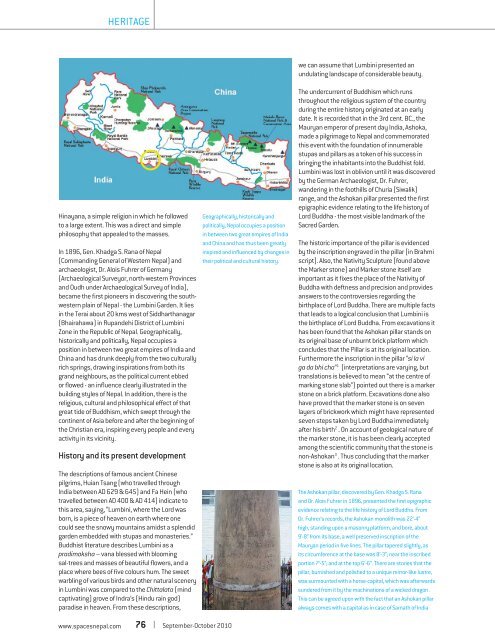5. September - October 2010
Create successful ePaper yourself
Turn your PDF publications into a flip-book with our unique Google optimized e-Paper software.
HERITAGE<br />
we can assume that Lumbini presented an<br />
undulating landscape of considerable beauty.<br />
Hinayana, a simple religion in which he followed<br />
to a large extent. This was a direct and simple<br />
philosophy that appealed to the masses.<br />
In 1896, Gen. Khadga S. Rana of Nepal<br />
(Commanding General of Western Nepal) and<br />
archaeologist, Dr. Alois Fuhrer of Germany<br />
(Archaeological Surveyor, north-western Provinces<br />
and Oudh under Archaeological Survey of India),<br />
became the first pioneers in discovering the southwestern<br />
plain of Nepal - the Lumbini Garden. It lies<br />
in the Terai about 20 kms west of Siddharthanagar<br />
(Bhairahawa) in Rupandehi District of Lumbini<br />
Zone in the Republic of Nepal. Geographically,<br />
historically and politically, Nepal occupies a<br />
position in between two great empires of India and<br />
China and has drunk deeply from the two culturally<br />
rich springs, drawing inspirations from both its<br />
grand neighbours, as the political current ebbed<br />
or flowed - an influence clearly illustrated in the<br />
building styles of Nepal. In addition, there is the<br />
religious, cultural and philosophical effect of that<br />
great tide of Buddhism, which swept through the<br />
continent of Asia before and after the beginning of<br />
the Christian era, inspiring every people and every<br />
activity in its vicinity.<br />
History and its present development<br />
The descriptions of famous ancient Chinese<br />
pilgrims, Huian Tsang (who travelled through<br />
India between AD 629 & 645) and Fa Hein (who<br />
travelled between AD 400 & AD 414) indicate to<br />
this area, saying, “Lumbini, where the Lord was<br />
born, is a piece of heaven on earth where one<br />
could see the snowy mountains amidst a splendid<br />
garden embedded with stupas and monasteries.”<br />
Buddhist literature describes Lumbini as a<br />
pradimoksha – vana blessed with blooming<br />
sal-trees and masses of beautiful flowers, and a<br />
place where bees of five colours hum. The sweet<br />
warbling of various birds and other natural scenery<br />
in Lumbini was compared to the Chittalata (mind<br />
captivating) grove of Indra’s (Hindu rain god)<br />
paradise in heaven. From these descriptions,<br />
www.spacesnepal.com 76<br />
<strong>September</strong>-<strong>October</strong> <strong>2010</strong><br />
Geographically, historically and<br />
politically, Nepal occupies a position<br />
in between two great empires of India<br />
and China and has thus been greatly<br />
inspired and influenced by changes in<br />
their political and cultural history.<br />
The undercurrent of Buddhism which runs<br />
throughout the religious system of the country<br />
during the entire history originated at an early<br />
date. It is recorded that in the 3rd cent. BC., the<br />
Mauryan emperor of present day India, Ashoka,<br />
made a pilgrimage to Nepal and commemorated<br />
this event with the foundation of innumerable<br />
stupas and pillars as a token of his success in<br />
bringing the inhabitants into the Buddhist fold.<br />
Lumbini was lost in oblivion until it was discovered<br />
by the German Archaeologist, Dr. Fuhrer,<br />
wandering in the foothills of Churia (Siwalik)<br />
range, and the Ashokan pillar presented the first<br />
epigraphic evidence relating to the life history of<br />
Lord Buddha - the most visible landmark of the<br />
Sacred Garden.<br />
The historic importance of the pillar is evidenced<br />
by the inscription engraved in the pillar (in Brahmi<br />
script). Also, the Nativity Sculpture (found above<br />
the Marker stone) and Marker stone itself are<br />
important as it fixes the place of the Nativity of<br />
Buddha with deftness and precision and provides<br />
answers to the controversies regarding the<br />
birthplace of Lord Buddha. There are multiple facts<br />
that leads to a logical conclusion that Lumbini is<br />
the birthplace of Lord Buddha. From excavations it<br />
has been found that the Ashokan pillar stands on<br />
its original base of unburnt brick platform which<br />
concludes that the Pillar is at its original location.<br />
Furthermore the inscription in the pillar “si la vi<br />
ga da bhi cha” 1 (interpretations are varying, but<br />
translations is believed to mean “at the centre of<br />
marking stone slab”) pointed out there is a marker<br />
stone on a brick platform. Excavations done also<br />
have proved that the marker stone is on seven<br />
layers of brickwork which might have represented<br />
seven steps taken by Lord Buddha immediately<br />
after his birth 2 . On account of geological nature of<br />
the marker stone, it is has been clearly accepted<br />
among the scientific community that the stone is<br />
non-Ashokan 3 . Thus concluding that the marker<br />
stone is also at its original location.<br />
The Ashokan pillar, discovered by Gen. Khadga S. Rana<br />
and Dr. Alois Fuhrer in 1896, presented the first epigraphic<br />
evidence relating to the life history of Lord Buddha. From<br />
Dr. Fuhrer’s records, the Ashokan monolith was 22’-4”<br />
high, standing upon a masonry platform, and bore, about<br />
9’-8” from its base, a well preserved inscription of the<br />
Mauryan period in five lines. The pillar tapered slightly, as<br />
its circumference at the base was 8’-3”; near the inscribed<br />
portion 7’-5”; and at the top 6’-6”. There are stories that the<br />
pillar, burnished and polished to a unique mirror-like lustre,<br />
was surmounted with a horse-capital, which was afterwards<br />
sundered from it by the machinations of a wicked dragon .<br />
This can be agreed upon with the fact that an Ashokan pillar<br />
always comes with a capital as in case of Sarnath of India

















